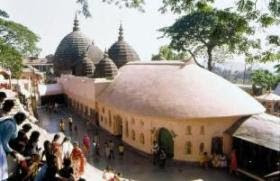
On the outskirts of Bhubaneswar, 15 km south-east of the city, is a small, circular temple, the Yogini Temple, dating to the early ninth century. It is hypaethral (open to the sky), and belongs to a genre of architecture completely apart from the major Orissan school. Although it seems that temples of this type existed throughout India at one time, today only four remain. Two of them are in Orissa; the shrine at Hirapur, and one in the far western reaches of the state, at Ranipur-Jharial.
The temple's circular wall, which is barely 2 meter high, contains 64 niches within its inner circumference. All except one of these contain an image of a Yogini Goddess. Some of the Goddesses are portrayed with sensual bodies and jewelled bodices, others with horrific shrunken features, still others with animal heads. Even today, standing in the deserted temple with bright sunshine pouring in, one senses a strange emanation from the temple, and this feeling is in keeping with its original purpose. Active between the ninth and thirteenth centuries, the cults responsible for these temples worshipped Yogini Goddesses in expectation of the direct acquisition of supernatural powers. TheYoginis were thought to be able to confer on their devotees the power to become microscopic or gigantic in size, to control the body and mind of oneself and of others, to fly, become invisible, and myriad other useful abilities. Worship seems to have centered on the repetition of the names of the Goddesses, and in later centuries, when active use of the shrines ceased, worshippers transferred their devotions to mystical paper diagrams.
The temple's circular wall, which is barely 2 meter high, contains 64 niches within its inner circumference. All except one of these contain an image of a Yogini Goddess. Some of the Goddesses are portrayed with sensual bodies and jewelled bodices, others with horrific shrunken features, still others with animal heads. Even today, standing in the deserted temple with bright sunshine pouring in, one senses a strange emanation from the temple, and this feeling is in keeping with its original purpose. Active between the ninth and thirteenth centuries, the cults responsible for these temples worshipped Yogini Goddesses in expectation of the direct acquisition of supernatural powers. TheYoginis were thought to be able to confer on their devotees the power to become microscopic or gigantic in size, to control the body and mind of oneself and of others, to fly, become invisible, and myriad other useful abilities. Worship seems to have centered on the repetition of the names of the Goddesses, and in later centuries, when active use of the shrines ceased, worshippers transferred their devotions to mystical paper diagrams.





